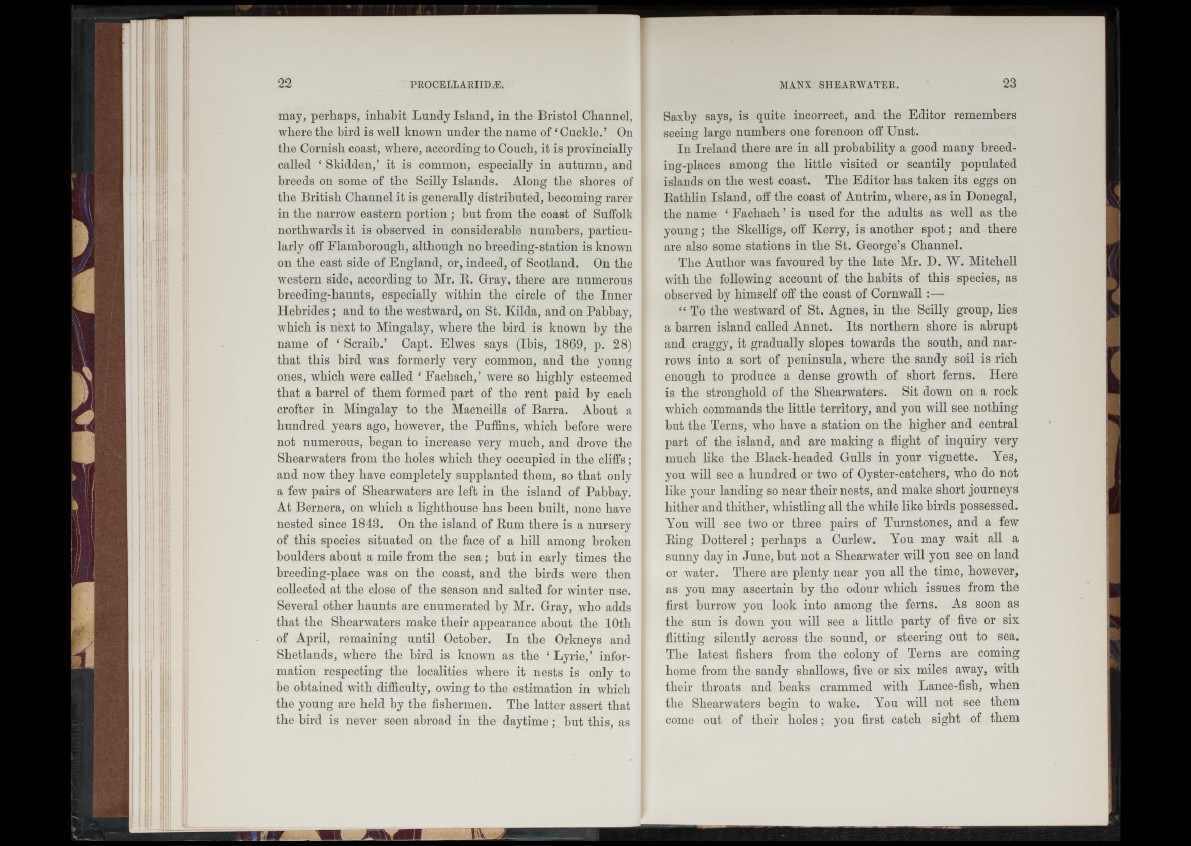
may, perhaps, inhabit Lundy Island, in the Bristol Channel,
where the bird is well known under the name of ‘Cuckle.’ On
the Cornish coast, where, according to Couch, it is provincially
called ‘ Skidden,’ it is common, especially in autumn, and
breeds on some of the Scilly Islands. Along the shores of
the British Channel it is generally distributed, becoming rarer
in the narrow eastern portion ; but from the coast of Suffolk
northwards it is observed in considerable numbers, particularly
off Flamborough, although no breeding-station is known
on the east side of England, or, indeed, of Scotland. On the
western side, according to Mr. B. Gray, there are numerous
breeding-haunts, especially within the circle of the Inner
Hebrides; and to the westward, on St. Kilda, and on Pabbay,
which is next to Mingalay, where the bird is known by the
name of ‘ Scraib.’ Capt. Elwes says (Ibis, 1869, p. 28)
that this bird was formerly very common, and the young
ones, which were called ‘ Fachach,’ were so highly esteemed
that a barrel of them formed part of the rent paid by each
crofter in Mingalay to the Macneills of Barra. About a
hundred years ago, however, the Puffins, which before were
not numerous, began to increase very much, and drove the
Shearwaters from the holes which they occupied in the cliffs;
and now they have completely supplanted them, so that only
a few pairs of Shearwaters are left in the island of Pabbay.
At Bernera, on which a lighthouse has been built, none have
nested since 1843. On the island of Rum there is a nursery
of this species situated on the face of a hill among broken
boulders about a mile from the sea; but in early times the
breeding-place was on the coast, and the birds were then
collected at the close of the season and salted for winter use.
Several other haunts are enumerated by Mr. Gray, who adds
that the Shearwaters make their appearance about the 10th
of April, remaining until October. In the Orkneys and
Shetlands, where the bird is known as the ‘ Lyrie,’ information
respecting the localities where it nests is only to
be obtained with difficulty, owing to the estimation in which
the young are held by the fishermen. The latter assert that
the bird is never seen abroad in the daytime ; but this, as
Saxby says, is quite incorrect, and the Editor remembers
seeing large numbers one forenoon off Unst.
In Ireland there are in all probability a good many breeding
places among the little visited or scantily populated
islands on the west coast. The Editor has taken its eggs on
Ratlilin Island, off the coast of Antrim, where, as in Donegal,
the name ‘ Fachach ’ is used for the adults as well as the
young; the Skelligs, off Kerry, is another spot; and there
are also some stations in the St. George’s Channel.
The Author was favoured by the late Mr. D. W. Mitchell
with the following account of the habits of this species, as
observed by himself off the coast of Cornwall:—
“ To the westward of St. Agnes, in the Scilly group, lies
a barren island called Annet. Its northern shore is abrupt
and craggy, it gradually slopes towards the south, and narrows
into a sort of peninsula, where the sandy soil is rich
enough to produce a dense growth of short ferns. Here
is the stronghold of the Shearwaters. Sit down on a rock
which commands the little territory, and you will see nothing
but the Terns, who have a station on the higher and central
part of the island, and are making a flight of inquiry very
much like the Black-headed Gulls in your vignette. Yes,
you will see a hundred or two of Oyster-catchers, who do not
like your landing so near their nests, and make short journeys
hither and thither, whistling all the while like birds possessed.
You will see two or three pairs of Turnstones, and a few
Ring Dotterel; perhaps a Curlew. You may wait all a
sunny day in June, but not a Shearwater will you see on land
or water. There are plenty near you all the time, however,
as you may ascertain by the odour which issues from the
first burrow you look into among the ferns. As soon as
the sun is down you will see a little party of five or six
flitting silently across the sound, or steering out to sea.
The latest fishers from the colony of Terns are coming
home from the sandy shallows, five or six miles away, with
their throats and beaks crammed with Lance-fish, when
the Shearwaters begin to wake. You will not see them
come out of their holes; you first catch sight of them